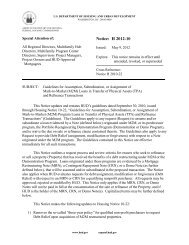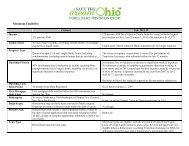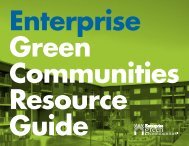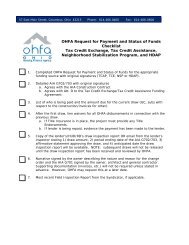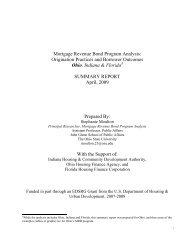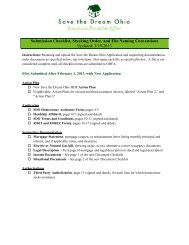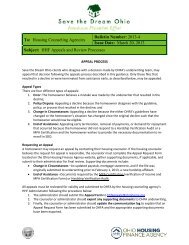chapter fourResearching <strong>the</strong> Property: Towards a Preservation StrategyThis chapter discusses <strong>the</strong> kinds of informationthat can be collected about a particular project,how to use it, and where to find it. The followingtypes of information will be addressed:1. Regulatory2. Market3. Ownership4. Financial5. Property Condition6. ResidentsIn most cases, <strong>the</strong> first two issues—regulatoryand market—will determine what strategies areeven possible, but <strong>the</strong> status and motivations of<strong>the</strong> existing ownership entity are also important.Project finances, property conditions, andresidents will also influence <strong>the</strong> preservationstrategy.Research into <strong>the</strong>se six areas should be <strong>the</strong>foundation of any preservation strategy.Research will help determine whe<strong>the</strong>r or not aproperty is at risk of conversion or restructuringand may suggest what <strong>the</strong> owner is likely to do.Research can help preservation advocates evaluatepotential purchase opportunities anddevelop a preservation plan. The more anorganization learns about <strong>the</strong> property, <strong>the</strong> betterits negotiating strategy or purchase plan willbe. Research also focuses community attentionon <strong>the</strong> project. Project research can be animportant organizing tool, and effective advocatesknow that knowledge is power.This chapter explains how to research each of<strong>the</strong> six issues. Each section begins with a quickreferencechart that summarizes key elementsof <strong>the</strong> issue area and <strong>the</strong>ir implications fordeveloping a preservation strategy, and eachsection concludes with a <strong>lis</strong>t of informationsources and where to find <strong>the</strong>m. 421. REGULATORYThe property’s existing regulatory framework isfundamental to determining both <strong>the</strong> constraintsand opportunities facing owners andprospective preservation purchasers. Many purchaseefforts have stalled because <strong>the</strong> partiesfailed to assess what was possible, or precluded,given <strong>the</strong> property's existing contractualand regulatory obligations.REGULATORY ISSUES AT A GLANCEIssueRental SubsidyContract StatusMortgage StatusLimited DividendResidual ReceiptsBond-Financed ProjectsImplications for Preservation StrategyDetermines eligibility for opt-out, owner/ purchaser opportunity to increaseproject income (or obligation to reduce it). Key timing and compliance issues.Indicates prepayment/ preservation status and eligibility;basis for determining owner compliance.Indicates potential conversion risk (or incentive to Mark-Up-To-Market).Indicates potential conversion risk.Potential additional restrictions.32chapter four: Researching <strong>the</strong> Property: Towards a Preservation Strategy
Rental Subsidy Contract StatusKnowing <strong>the</strong> status of a project’s rental subsidycontract will help to determine whe<strong>the</strong>r <strong>the</strong>owner might have a chance to opt-out, whe<strong>the</strong>r<strong>the</strong>re is an opportunity to increase projectincome, or whe<strong>the</strong>r <strong>the</strong>re is an obligation toreduce rents—and when <strong>the</strong>se changes are likelyto occur. These variables will also frame <strong>the</strong>opportunities available to a preservation purchaser.Understanding <strong>the</strong> contract can alsoprovide a basis for assessing <strong>the</strong> owner’s compliancewith applicable requirements.Type/Date. Does <strong>the</strong> property have one or morerental subsidy contracts and, if so, what type—Section 8 Loan Management Set-Aside, Section8 New Construction/Substantial Rehab, Section8 Mod Rehab, Rental Assistance Program orRent 43 Supplement? Is it an original pre-MAHRAcontract or a post-MAHRA contract renewal (i.e.,executed after October 27, 1997)? The type ofcontract and its execution date will determine<strong>the</strong> available renewal and rent increase options.Only projects with post-MAHRA contractrenewals, for example, are eligible for Mark-Upto-Market.Expiration. What is <strong>the</strong> contract expiration date?If expiration is imminent, <strong>the</strong> property is morelikely to be at-risk. Conversely, <strong>the</strong>re may begreater opportunities for preservation (forexample, Mark-Up-to-Market) at <strong>the</strong> point ofcontract expiration.Coverage. What percentage of <strong>the</strong> units is covered—partialor 100 percent? This will determine<strong>the</strong> value of any incentives that involveonly <strong>the</strong> Section 8 units (for example, Mark-Up-To-Market).Renewal Request. If <strong>the</strong> contract is expiringsoon, has <strong>the</strong> owner filed a request to renew oropt out? HUD requires this notice be filed atleast four months prior to <strong>the</strong> contract expirationdate.Opt-Out Notice. Has as an opt-out notice beensent to <strong>the</strong> tenants? HUD requires this notice atleast one year prior to date of contract termination.Mark-to-Market Status. If <strong>the</strong> contract is expiring,is <strong>the</strong> project in <strong>the</strong> Mark-to-Marketpipeline? If so, what is its status?Mortgage StatusThe nature of <strong>the</strong> property's first mortgage mayaffect a wide range of variables including <strong>the</strong>owner's right to prepay, continuation of userestrictions, eligibility for programs such asMark-to-Market, notice requirements, dividendrestrictions, and Residual Receipts status.These factors will influence <strong>the</strong> owner's decisionsas well as opportunities for a preservationtransaction.Lender Type. Is <strong>the</strong> mortgage insured or held byHUD? Financed by a state or local agency? By aprivate lender? This could affect eligibility forcertain types of programs (e.g. only projectswith HUD-insured or HUD-held mortgages areeligible for Mark-to-Market). Also, if <strong>the</strong> mortgageis, or was once, held by HUD, <strong>the</strong> ownermay be obligated to maintain <strong>the</strong> originalaffordability for <strong>the</strong> full mortgage term.Program. If <strong>the</strong> mortgage is insured or subsidizedby HUD, what is <strong>the</strong> applicable program?If it is a Section 221(d)(3) BMIR or 236 project,mortgage prepayment may be a concern.Section 221(d)(4) and Section 220 are commontypes of financing for Section 8 NewConstruction/Substantial Rehab projects.Section 202 projects are nonprofit-owned andtypically have no conversion risk.Prepayment Eligibility. If <strong>the</strong> mortgage is subsidizedunder Section 221(d)(3) BMIR or 236, is itan expiring use project that is eligible to prepay?Does it have any characteristics that mightprohibit or complicate prepayment?For example, if <strong>the</strong> original owner/mortgagorwas a nonprofit, or if <strong>the</strong> project is HUD-insuredwith a Rent Supplement contract, prepayment isprohibited without HUD consent. If <strong>the</strong> projectreceived Flexible Subsidy assistance, it shouldhave a 40-year use agreement and may alsohave a prepayment restriction.If <strong>the</strong> project is eligible to prepay, when is <strong>the</strong>prepayment eligibility date? For eligible HUDchapterfour: Researching <strong>the</strong> Property: Towards a Preservation Strategy33



